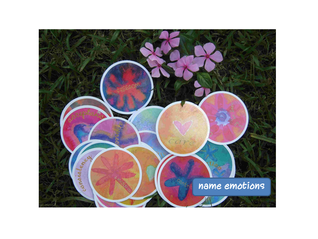JOYFUL MIND WELLBEING
|
Emotional roller coaster taking you for a ride? Take on board this awesome tip (because the smallest tweaks often make the biggest impact). Warning: handling powerful emotions might be easier than you think !!! It may seem hard to believe and too good to be true, but naming the particular emotion you feel will calm it substantially. Yep, it’s that easy. Simply naming emotions can turn down their heat and intensity. Here’s a quick zoom through the science to inspire you. SCIENCE INVESTIGATES Using the latest and greatest in brain-scanning, the fMRI, Research psychologist Matthew Lieberman at the University of California at Los Angeles (UCLA), set out to test the ‘naming is taming’ hypothesis. fMRI stands for ‘functional magnetic resonance imaging’. It’s been around since 1991 and has revolutionized knowledge about the brain. The fMRI scanner reveals which parts of the brain are active and inactive at any given moment. They generate the colourful cross-section photos of the brain that accompany scientific reports. THE EXPERIMENT Lieberman and his colleagues hooked up 30 ‘subjects’ to fMRI. They watched to see what happened as participants viewed graphic photos of people’s faces in the grip of intense emotions. Rage, despair, fear: the whole goddamn theme park. The brain images of the ‘subjects’ viewing the photos showed a predictable disturbance. The alarm centre of the amygdala, an ancient part of the brain, was triggered. At the same time, the more evolved part of the brain responsible for rational executive functions, the pfc, was disabled. This is the usual process when we are faced with threats: the amygdala reacts, the pfc goes offline. The process helped us evolve for survival. THE BREAKTHROUGH Lieberman was not the least surprised by the results. But he had something more in mind. He wanted to prove that naming emotions could tame them, so he set up a series of variables. First he showed participants the photos again, this time with people’s names attached to each picture (Billy, Sue, Jake, etc). As subjects looked at the upsetting photos and read the names, there was no change to their brain imaging. It still showed the usual distress response. Then he showed participants the same photos, this time the faces labelled by gender rather than by name. Still no change to the brain. THE TWEAK Then Lieberman brought out his trump card. His aim, remember, was not simply to observe how subjects reacted, but to see if they could cool down their emotional reaction. Could he get their brains to bypass the usual scenario? Could he get them to by-pass the hard-wired emotional reaction of the amygdala and bring the pfc back online? Could it be done? Oh yes it could. Lieberman’s master stroke was to label the faces in the photos with the emotion they were experiencing. The angry face now had ‘anger’ written beneath it; the fearful face had ‘fear’. Now the subjects read the name of the emotion as they looked at the pained faces in the photos. That is, they named the emotion. And guess what? Scans showed their amygdala calm down by a full fifty per cent and the pfc, the executive function, start to come back online. Reading people’s names and gender had made no difference. But naming the emotion made the world of difference. The distress response was greatly eased simply by naming the emotion. Lieberman had proved his point: naming emotions tames them. MINDFULNESS PRACTICE FOR TAMING EMOTIONS What you can do right now: Next time you’re in the grip of heavy emotions, try naming them. First you will need to identify how you feel. That requires mindfulness, being in the moment and feeling into your body. Notice where uncomfortable sensations are present and zone into them. Breathe into the emotion/sensation and see what word arises. The more you can pinpoint the exact emotion the better. NVC (Non-Violent Communication) has a good range of resources for emotion-naming. Read from the copious list and see what jumps out at you. Or invest in Paulette Brai-Narai’s brilliant and colourful emotion-naming cards from expresspeace.com Like it? Share it! I love to hear from my readers. Please have your say in the comments! Go on!
0 Comments
Leave a Reply. |
Categories
All
Categories
All
|
ServicesYoga Online
Mindfulness Coaching |
|



 RSS Feed
RSS Feed